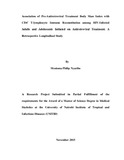| dc.description.abstract | Human immunodeficiency virus (HIV) infection, causes acquired immune deficiency
syndrome (AIDS) condition which is the world’s leading pandemic that causes millions
of deaths each year. HIV has no cure, infected patients rely on effective management
with the use of antiretroviral treatment to ensure suppression of viral replication, increase
of CD4+ T-lymphocyte cells and increased time to disease progression, so that people
living with HIV can enjoy health lives and reduce the risk of transmitting the virus to
others.
CD4+ count monitoring is an essential tool for initiating and monitoring of antiretroviral
treatment and is greatly used in developing countries where Kenya is included. CD4+
response is dependent on; environmental setting where treatment is being offered,
individual and population characteristics that include; adherence, age, gender, baseline
CD4+ cell count, baseline viral load and the individuals Basal Metabolic Index (BMI)
which is a measure of the patients nutritional status and is estimated as weight divided by
height-squared (kg/m2). This study attempts to provide a more recent, updated and clear
association of these variables that independently predict patient’s CD4+ immune
reconstitution.
This is a retrospective longitudinal study of ART-naïve, HIV-infected adults and
adolescents initiated on standard first line Anti-Retroviral Treatment regimen and their
CD4+ response followed up for 18 months. Study population included adults and
adolescents registered and initiated on standard first line Anti-Retroviral Treatment
regimen, as part of routine comprehensive care program of the Kenyan Government in
conjunction with donor partners; USAID, ICAP and EGPAF at Masaba-North SubCounty PSC/CCC.
Statistical Analysis was done using multilevel mixed effect linear models in STATA to
analyze the BMI categories CD4+ level intercept values and other variables coefficients
and compare them to their reference groups to obtain P values. Repeated measures
Analysis of variance was also used to determine if there a difference in CD4+ mean
response between the four intervals of measurement. Results from the study indicate that
BMI is an independent predictor of CD4+ lymphocyte cells immune reconstitution for
patients on antiretroviral treatment. While Age, Gender, and Number of ART
interruptions were statistically significant when other variables were accounted for in the
model over the 18 months of follow up. Whereas baseline BMI and WHO clinical stage
were less statistically significant. | en_US |
| dc.description.department | a
Department of Psychiatry, University of Nairobi, ; bDepartment of Mental Health, School of Medicine,
Moi University, Eldoret, Kenya | |

